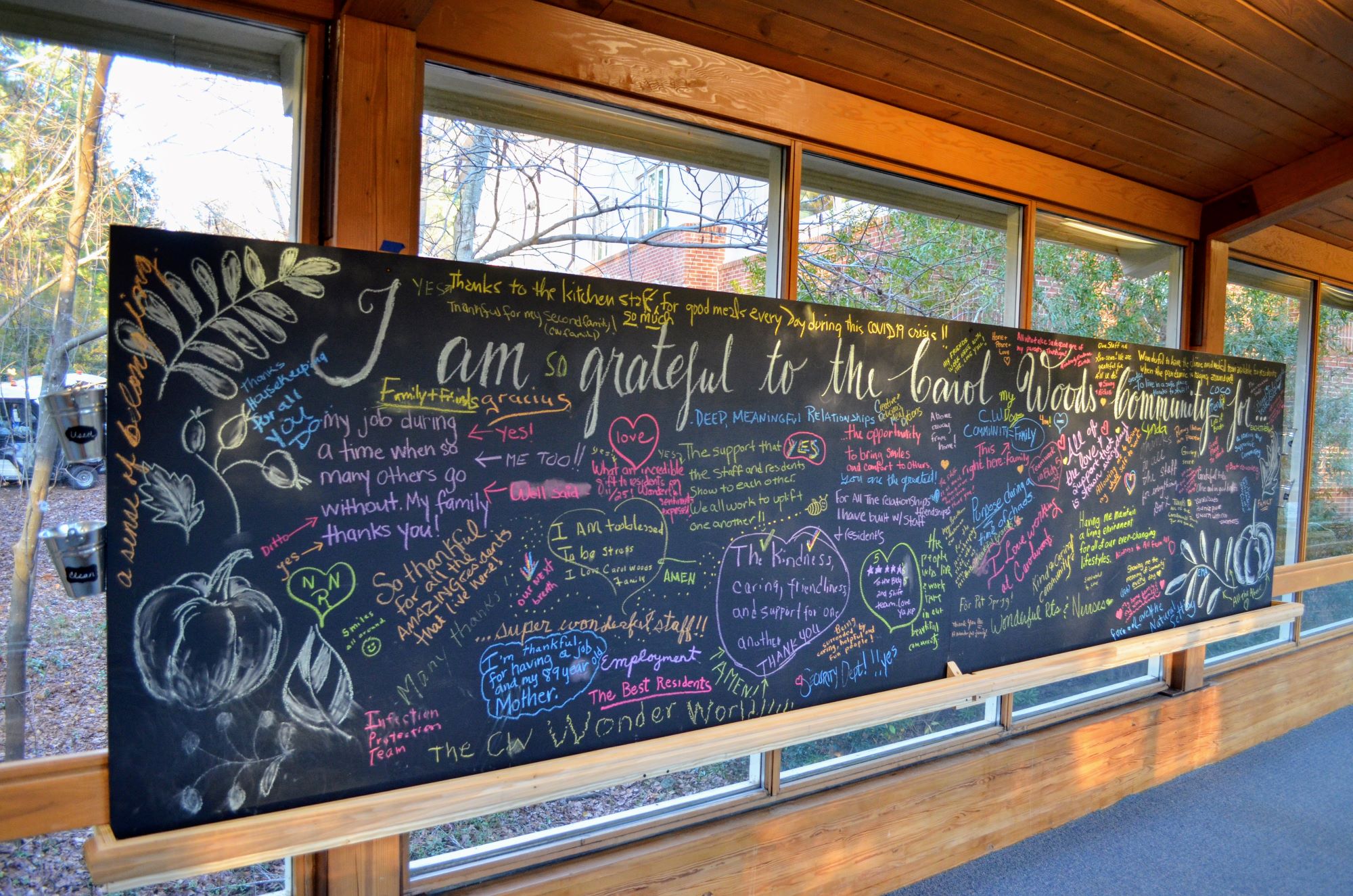
Employee Engagement, Employee Experience, Leadership & Management
Image: Carol Woods leaders put up a 20-foot-long blackboard, and invited staff and residents to weigh in on prompts such as, “What during this crazy time gives you joy?”
During one of the most difficult years in memory, employees at Carol Woods Retirement Community said their company culture improved.
And in some areas, by a lot.
Carol Woods’ 320 or so employees reported that their Chapel Hill, N.C., organization got better, even amid the COVID pandemic, the related economic downturn, and a racial reckoning that shook the country.
While scores on the Great Place To Work® Trust Index™ employee survey dipped for the aging services industry overall, Carol Woods’ overall Trust Index score edged up from 83 in 2020 to 84 in 2021.
The Trust Index, which assesses employees’ experience of their company culture through 60 survey statements, helps determine the Fortune Best Workplaces for Aging Services™. In 2021, the sum of positive employee opinions at Carol Woods saw the organization take the #6 spot in the small-size business category – a six-position jump from 2020.
The improved ranking owed in part to significant increases in management’s approachability, overall collegiality at the organization, and a feeling of mutual care. Compared to the previous period, in 2021:
- +7% more employees said that managers are approachable and easy to talk to, climbing to 87% overall.
- +6% more employees reported that people avoid politicking and backstabbing, rising to 74%.
- +7% more employees agreed that “people care about each other here,” climbing to 84%.
What accounted for Carol Woods’ progress during a very rough time? And what lessons can Carol Woods offer to other organizations in senior living and hospitality seeking to build a resilient, high-trust, inclusive, high-performance company culture?
Great Place To Work recently spoke with Pat Sprigg, who captained Carol Woods during the pandemic. In August, Pat stepped down from her role as CEO of the organization. She served as head of Carol Woods for 29 years.
Pat never expected her last year as CEO to be filled with so many overlapping challenges. But she couldn’t have been prouder of how the Carol Woods community responded.
“Organizations showed who they were,” Pat says. “The crisis brought out the best in us. It amplified our strengths.”
Here are the five steps Pat and her team took to thrive in a tough time:
1. Communicate long and short
Even before COVID hit, Pat and Carol Woods leadership were working to improve communication – the topic had showed up as a weakness in previous Trust Index survey results.
The pandemic pushed effective communication even higher up the priority list. Among the changes was increasing the frequency of company-wide messages, from a monthly newsletter to a near-daily briefing.
Pat and team also send short text messages with crystal-clear headlines, such as “All residents have tested negative.” Says Pat: “Never underestimate the importance of repeating information.”
But for Carol Woods, communication also meant listening. The company instituted short “stand-up” meetings at the beginning of shifts to gather employee input and learn about problems faced by staff.
Leaders also put up a 20-foot long blackboard, and invited staff and residents to weigh in on prompts such as, “What, during this crazy time, gives you joy?”
2. Acknowledge emotions
Asking about joys relates to the second key Pat highlighted for flourishing during the past year: acknowledging employee emotions. Like other great workplaces, Carol Woods realized that 2020 put staff under unprecedented pressure.
“Never underestimate the importance of repeating information.”
Worries about physical safety, family well-being and financial security were front and center for many people – especially in industries such as senior care, health care and hospitality.
Early on in the pandemic, Pat took one of those sources of anxiety off the table. She declared that no one would be laid off. Residents went a step further, creating a hardship fund to help employees whose spouses lost jobs or otherwise needed financial help.
More generally, Carol Woods leaders made space for staff to express how they were feeling. Says Pat: “We were learning to check in on the emotional level, and not just the work level.”
3. Lead by example
Pat and her team were in the trenches with the rest of the Carol Woods staff during the crises of 2020 and 2021. For instance, Pat and her team helped screen employees for COVID symptoms at the entrance of the complex. “I was out there at 5 a.m. in the driveway greeting staff, taking temperatures,” Pat says.
These dawn patrol shifts showed employees that leaders weren’t above hands-on, hard work. They also allowed Pat and other Carol Woods execs to learn about staff needs.
“We were learning to check in on the emotional level, and not just the work level.”
Among the insights: Some employees were struggling to shop for themselves and their families. The result? “We created a grocery store,” Pat recalls. Carol Woods purchased extra food and other items from vendors and enabled employees to buy the goods.
Housekeepers – who were idle after the organization stopped cleaning the apartments of “independent living” residents to minimize COVID risks – staffed the “store.”
4. Invite your staff to rise to the occasion
Another lesson from Pat and her team: Your people can do remarkable things if you ask them. In line with federal and state guidance, Carol Woods banned all visitors to its health center to prevent the spread of the COVID.
As a result, Pat recalls, “120 residents suffered the loss of human contact.” What’s more, most of these individuals were living with dementia. The pandemic made a disorienting disease even more confusing.
In response, Pat and other leaders asked employees to fill in for family members by “adopting” a resident.
The head of grounds at Carol Woods was reluctant at first. But Pat counseled him to “just be your authentic self.” Sure enough, the staffer developed a close relationship with his “adopted” resident. The pair made a windchime out of bamboo. That connection “became such an enriching experience,” Pat says.
5. Show appreciation, inclusively
It’s also important to recognize employees for their good work, Pat says. At Carol Woods, appreciation took many forms over the past 18 months. It included free lunches and ice cream parties as well as cash bonuses.
Carol Woods also gave employees the day off if they got vaccinated. And if an employee ran out of paid-time-off because of a COVID-related quarantine, the company covered those missed days.
One thing Pat stresses is even-handedness. Some employees on the night and weekend shifts commented that the day-time staffers were getting free lunches without a comparable perk for those working off-hours.
That led Carol Woods leaders to arrange for all employees to be able to order a free meal online, and consume it during their shift. “When you hand out something,” Pat says, “you better be sure to hand it out to everybody.”
Get recognized as a great place to work
Is your senior living organization or hospitality company doing the things Carol Woods did to thrive during a difficult year? Apply to be a Great Place To Work-Certified™ company and earn a place on one of our Best WorkplacesTM lists.
Are you seeking help in improving your culture? Connect with us to learn about your strengths and areas to improve.









